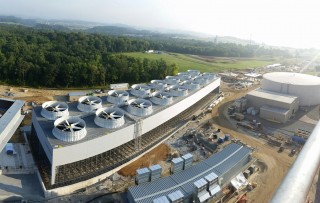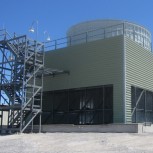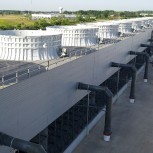Counterflow Tower Arrangement
A variety of counterflow tower layouts are available to meet the unique plot requirements of each individual project. An in-line tower is the standard layout for efficiency reasons, but parallel in-line, back-to-back, and round configurations are also options when the plot plan requires a different approach.
For more information, contact EvapTech at [email protected] for guidance on meeting the challenges of your project layout.
The vast majority of new counterflow towers are constructed of fire retardant fiberglass because of its high strength and fire/corrosion resistive properties. EvapTech's Newton, IL facility manufactures these pultruded parts, allowing superior quality and lead time control.
Round Configuration
When site restrictions dictate truly thinking outside the counterflow "box", a round configuration may provide the right solution for your challenging project site.
In-line Configuration
The most efficient and cost effective approach to tower design. Constructing the tower in a linear fashion provides the arrangement with the least parasitic power consumption, including reduced fan energy consumption and lowest pumping head. By providing efficient entering air access, the tower height and cost is minimized.
Back-to-Back Configuration
When dictated by site constraints, a back-to-back tower configuration can fit within site limitations not possible with an in-line arrangement. However, reduced thermal efficiency and added cost result from a cooling tower arranged in a back-to-back configuration with both increased fan energy and substantially increased pumping head.
Parallel In-line Configuration
When dictated by site constraints that would not allow a long single tower in-line arrangement, why not consider splitting the tower into two or more units arranged in a parallel in-line configuration. Although the overall tower footprint is wider than that made possible by utilizing a back-to-back configuration, consider the advantages:
- Substantially reduced tower pumping head by splitting the air inlet area between two tower faces
- Substantially reduced tower cost made possible by a reduced tower height and gained efficiency
- Reduced fan energy by regaining lost efficiency with two air inlets
- Reduced installed length by utilizing the area between towers for pump pits, MCC, piping, and access provisions
- More reliable thermal capacity by cutting the air draw through the falling water in half
- Easier maintenance and staged operation by providing the facility with easily isolated towers
Mechanical Equipment Support
Equally as important as the mechanical component selection, equipment support design utilizing a properly sized round torque tube to effectively restrain rotational dynamic loads is essential to assuring the longevity of these costly and critical tower components. The devil is in the details and the design details of support bracing and its attachment to the tower structure will determine if the support effectively restrains rotational and vibration loads.
The EvapTech Edge:
Support Sizing: EvapTech properly sizes the torque tube for the fan diameter and applied horsepower - Flexing of undersized supports is a common cause of reduced gear, motor, and driveshaft operating life.
Support Design: Equipment mounting plates braced against movement in all directions - simple bent plates welded to the tube do not provide the rigidity required by the driveshaft and will ultimately lead to failure of the shaft and gear/motor bearings.
Positive Positioning: Jack bolts are provided for ease of alignment and assure properly secured motor and gear placement - do not rely upon a simple spiral pin to maintain alignment during numerous start/stop cycles.
Structural Attachment: Torque tube loading must be applied directly to the tower's vertical column framing with steel plates bolted directly from the support to vertical framing members - never allow horizontal framing members, plastic grommets, or hollow leg fan deck panels sandwiched between the support and tower framing to be used to transmit loads.
Vibration Bracing: Diagonal bracing immediately below the supports transmits and spreads loads into the surrounding structure - Both pultruded fiberglass and timber are unidirectional strength materials, anticipating that vibration loading will be adequately restrained by moment loading of these members will result in a substantially reduced life cycle of mechanical components.



